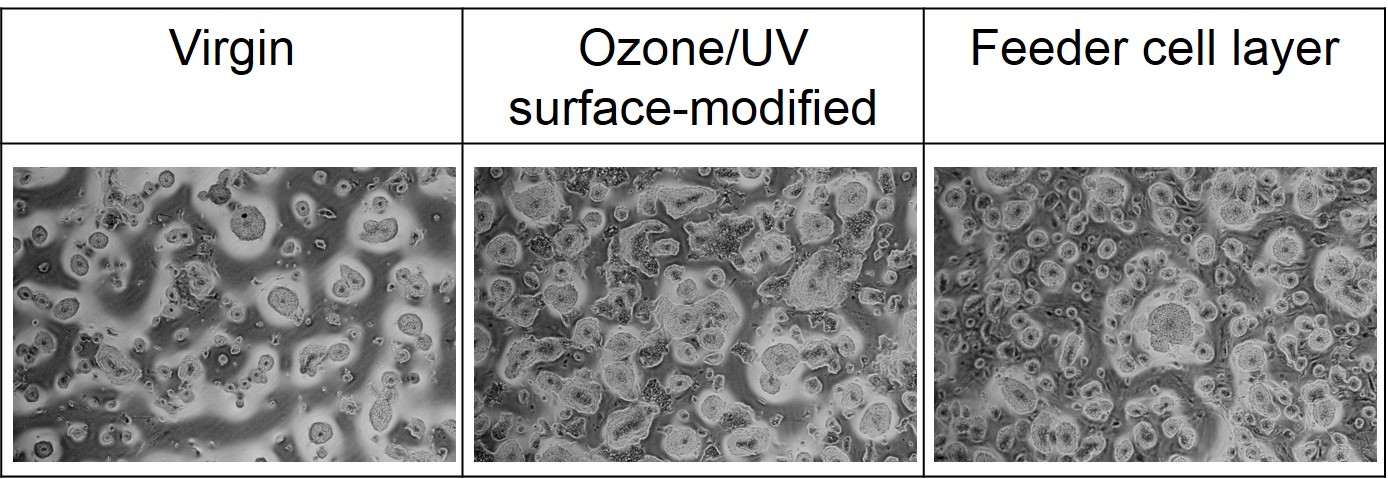Feeder-free culture of mouse embryonic stem cells using ozone/UV surface-modified substrates
-
1
Keio University, Graduate School of Science and Technology, Japan
-
2
Ebara Jitsugyo Corp., Japan
-
3
Keio University, Faculty of Science and Technology, Japan
Introduction: Culturing pluripotent stem cells effectively requires feeder cell layers or coating by specially conditioned extracellular matrixes (ECM). However, to apply the pluripotent stem cells as resources for regenerative medicine, feeder cell layers or animal-derived factors have to be removed for to establish of xeno-free culture condition. To enable the xeno-free culture system, we focused on Ozone/UV surface treatment of polystyrene substrates to improve adhesion and proliferation of pluripotent stem cells. The ozone/UV treatment modifies the hydrophilic property and molecular structure of polystyrene surface by ozone oxidation. In this study, as a fundamental research for the xeno-free culture system of embryonic stem cells (ESCs), mouse ESCs (mESCs) were cultured on the modified polystyrene substrates without the feeder cell layers. The adhesion, proliferation, and pluripotency were evaluated.
Materials and Methods: The polystyrene substrates were modified by ozone/UV radiation. The wavelength of UV lamps was 185 nm and 254 nm. Virgin polystyrene, ozone/UV surface-modified polystyrene, and polystyrene with feeder cell layer were used as culturing substrate. The mESCs were cultured on the substrates during 2 days. The microscopic images of the cells were acquired during the culture. Also the DNA amount of the cells per dish at the time point of 2 days after cell seeding was measured to evaluate the adhesion and proliferation.
Results: The microscopic images of the cells are showed in Figure 1. Also the DNA amount per dish is shown in Figure 2. While the cells on the virgin polystyrene were not adhered, the adhesion and proliferation rate of mESCs on the ozone/UV surface-modified polystyrene showed similar values to those on feeder cell layer. And the cells on both substrates formed colonies which were positive for alkaline phosphatase staining stained.


Discussion: The cell proliferation rate on ozone/UV surface-modified polystyrene were significantly greater than the number of cells on the virgin polystyrene. It is considered that the molecular structure modified by ozone/UV treatment promoted the adhesion of the ESCs and kept their pluripotency. Then, it could be considered that the modified surface played the similar role to feeder cell layer.
Conclusion: In conclusion, it was suggested that the ozone/UV surface-modified polystyrene substrates made it possible to culture mESCs in feeder-free condition without any chemical treatment for substrates.
Keywords:
Cell Proliferation,
stem cell,
Surface modification,
Polymeric material
Conference:
10th World Biomaterials Congress, Montréal, Canada, 17 May - 22 May, 2016.
Presentation Type:
Poster
Topic:
Cellular migration and biomaterials
Citation:
Kasai
K,
Nakata
H and
Miyata
S
(2016). Feeder-free culture of mouse embryonic stem cells using ozone/UV surface-modified substrates.
Front. Bioeng. Biotechnol.
Conference Abstract:
10th World Biomaterials Congress.
doi: 10.3389/conf.FBIOE.2016.01.01845
Copyright:
The abstracts in this collection have not been subject to any Frontiers peer review or checks, and are not endorsed by Frontiers.
They are made available through the Frontiers publishing platform as a service to conference organizers and presenters.
The copyright in the individual abstracts is owned by the author of each abstract or his/her employer unless otherwise stated.
Each abstract, as well as the collection of abstracts, are published under a Creative Commons CC-BY 4.0 (attribution) licence (https://creativecommons.org/licenses/by/4.0/) and may thus be reproduced, translated, adapted and be the subject of derivative works provided the authors and Frontiers are attributed.
For Frontiers’ terms and conditions please see https://www.frontiersin.org/legal/terms-and-conditions.
Received:
27 Mar 2016;
Published Online:
30 Mar 2016.
*
Correspondence:
Dr. Kohei Kasai, Keio University, Graduate School of Science and Technology, Yokohama, Kanagawa, Japan, k.kasai@keio.jp
Dr. Hideo Nakata, Ebara Jitsugyo Corp., Kawasaki, Japan, Email1
Dr. Shogo Miyata, Keio University, Faculty of Science and Technology, Yokohama, Japan, miyata@mech.keio.ac.jp